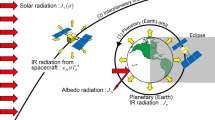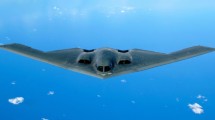Abstract
Deployable membrane structures are expected to be used for large-area space structures, such as solar propulsion sails, magnetoplasma sails, drag-deorbiting sails, membrane antennas, and solar power sails. They are lightweight and can be compactly stored at launch. One achievement of the Japan Aerospace Exploration Agency (JAXA) was the successful deployment of a 200 m2 sail using centrifugal force in the IKAROS mission, which was the first solar propulsion sail-craft in history. JAXA has long been studying the technology of spin deployment of sail membranes, and is currently planning the spin deployment of a class sail larger than 2000 m2 as the next step in the development of the IKAROS technology. This paper discusses the unexpected behaviors during on-orbit sail deployment by IKAROS, as well as problems with the sail holding method, and proposes an improved sail storage structure and deployment mechanism for the OKEANOS mission.
Similar content being viewed by others
Change history
11 February 2022
A Correction to this paper has been published: https://doi.org/10.1007/s42064-022-0136-2
References
Macdonald, M. Advances in Solar Sailing. Berlin, Heidelberg: Springer-Verlag Berlin Heidelberg, 2014.
Greschik, G., Mikulas, M. M. Design study of a square solar sail architecture. Journal of Spacecraft and Rockets, 2002, 39(5): 653–661.
Hinkle, J. D., Warren, P., Peterson, L. D. Geometric imperfection effects in an elastically deployable isogrid column. Journal of Spacecraft and Rockets, 2002, 39(5): 662–668.
Johnson, L., Castillo-Rogez, J., Dervan, J., Mcnutt, L. Near Earth Asteroid (NEA) scout. In: Proceedings of the 4th International Symposium on Solar Sailing, 2017: 17002.
Betts, B., Spencer, D. A., Nye, B., Munakata, R., Bellardo, J. M., Wong, S. D., Diaz, A., Ridenoure, R. W., Plante, B. A., Foley, J. D., Vaughn, J. LightSail 2: Controlled solar sailing using a CubeSat. In: Proceedings of the 4th International Symposium on Solar Sailing, 2017: 17053.
Nakanishi, H., Sakamoto, H., Furuya, H., Yamazaki, M., Miyazaki, Y., Watanabe, A., Watanabe, K., Torisaka, A., Oda, M. Development of nano-satellite OrigamiSat-1 with highly functional deployable membrane. In: Proceedings of the 4th International Symposium on Solar Sailing, 2017: 17085.
Mori, O., Kato H., Matsumoto, J., Saiki, T., Tsuda, Y., Ogawa, N., Mimasu, Y., Kawaguchi, J., Tanaka, K., Toyota, H., et al. Direct exploration of Jupiter Trojan asteroid using solar power sail. In: Proceedings of the 4th International Symposium on Solar Sailing, 2017: 17087.
Tsuda, Y., Mori, O., Takeuchi, S., Kawaguchi, J. Flight result and analysis of solar sail deployment experiment using S-310 sounding rocket. Space Technology, 2006, 26(1–2): 33–39.
Mori, O., Shida, M., Kawaguchi, J., Nishimaki, S., Matsumoto, M., Shibasaki, Y., Hanaoka, F., Arakawa, M., Sugita, M. Static deployment of large membrane of spinning solar sail using a balloon. In: Proceedings of the 17th Space Flight Mechanics Meeting, 2007: AAS 07–167.
Saiki, T., Nakaya, K., Yamamoto, T., Tsuda, Y., Mori, O., Kawaguchi, J. Development of a smallspin-axis controller and its application to a solar sail subpayload satellite. Transactions of the Japan Society for Aeronautical and Space Sciences, Space Technology Japan, 2009, 7: 25–32.
Sawada, H., Mori, O., Okuizumi, N., Shirasawa, Y., Miyazaki, Y., Natori, M., Matunaga, S., Furuya, H., Sakamoto, H. Mission report on the solar power sail deployment demonstration of IKAROS. In: Proceedings of the 52nd AIAA/ASME/ASCE/AHS/ASC Structures, Structural Dynamics and Materials Conference, 2011: AIAA 2011–1877.
Shirasawa, Y., Mori, O., Okuizumi, N., Sawada, H., Miyazaki, Y., Sakamoto, H., Furuya, H., Matunaga, S. Analysis on membrane deployment dynamics of solar sail using multi-particle model. In: Proceedings of the 20th Workshop on Astrodynamics and Flight Mechanics, 2010: A–8.
Shintaku, K., Matunaga, S., Ono, G., Sakamoto, H., Satoh, T., Mori, O., Shirasawa, Y., Okuizumi, N. Experiment and analysis of spinning membrane deployment focusing on shape imbalance for solar sail. Transactions of the Japan Society for Aeronautical and Space Sciences, Aerospace Technology Japan, 2014, 12(ists29): Pc 55–Pc 62.
Saito, K., Okuizumi, N., Sakamoto, H., Kikuchi, J., Matsumoto, J., Furuya, H., Mori, O. Experimental research on roll-up storage method for a large solar sail. In: Proceedings of the 4th International Symposium on Solar Sailing, 2017: 17082.
Okuizumi, N., Mori, O., Matsumoto, J., Saito, K., Sakamoto, H., Kayaba, A., Shirasawa, Y. Development of deployment structures and mechanisms of spinning large solar power sail. In: Proceedings of the 4th International Symposium on Solar Sailing, 2017: 17043.
Author information
Authors and Affiliations
Corresponding author
Additional information
Osamu Mori received his Ph.D. degree in engineering from Tokyo Institute of Technology, Japan, in 2002. He is currently an assistant professor at Institute of Space and Astronautical Science, Japan Aerospace Exploration Agency. His research includes spacecraft systems, multibody dynamics, guidance, navigation and control. He is a project manager of the IKAROS mission and a core member of the OKEANOS mission.
Nobukatsu Okuizumi received his bachelor, master, and Ph.D. degrees in mechanical engineering from Tokyo Institute of Technology in 1989, 1991, and 1998, respectively. He is an assistant professor at the Institute of Space and Astronautical Science, Japan Aerospace Exploration Agency. His research interests include lightweight deployable structures, spacecraft structures, and nonlinear dynamics of mechanical and structural systems. He has also been engaged in the development of various scientific spacecrafts such as Akatsuki, IKAROS, Hayausa2, etc.
Toshihiro Chujo received his Ph.D. degree in engineering from the University of Tokyo, Japan, in 2017. He is currently an assistant professorat Tokyo Institute of Technology. He was previously a postdoctoral researcher at Institute of Space and Astronautical Science (ISAS), Japan Aerospace Exploration Agency (JAXA), working on the Solar Power Sail OKEANOS mission and the Transformable Spacecraft mission. His main field of study is spacecraft system, mission analysis, and astrodynamics.
Yuki Takao received his bachelor and master degrees in aerospace engineering from the University of Tokyo, Japan, in 2015 and 2017, respectively. He is now pursuing his Ph.D. degree in the University of Tokyo under the direction of Prof. Kawaguchi. His research specialties are astrodynamics, spacecraft navigation, structural dynamics, and especially, solar sails. His master’s thesis focused on active shape control of solar sail membrane. He received JAXA President Award at the 31st International Symposium on Space Technology and Science for his work on the topic. He has been working on the Solar Power Sail OKEANOS mission and the Asteroid Explorer Hayabusa2 mission at Institute of Space and Astronautical Science (ISAS), Japan Aerospace Exploration Agency (JAXA).
Rights and permissions
About this article
Cite this article
Mori, O., Okuizumi, N., Chujo, T. et al. Improvement of sail storage and deployment mechanism for spin-type solar power sail. Astrodyn 4, 223–231 (2020). https://doi.org/10.1007/s42064-019-0063-z
Received:
Accepted:
Published:
Issue Date:
DOI: https://doi.org/10.1007/s42064-019-0063-z




